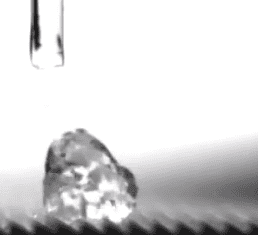
Last week we showed you some great fluid dynamics at work – water bridges between two beakers connected to high voltage current. Water and fluids in particular sometimes behave in amazing ways under certain conditions. Today, I’d like to show another dazzling display: the Leidenfrost effect. This is a phenomenon that occurs when liquid, say water, is in near contact with a mass significantly hotter than the liquid’s boiling point, producing an insulating vapor layer which keeps that liquid from boiling rapidly and keeps the surfaces separate. You’ve likely seen in it action countless times but never knew what’s it called. For instance, when you heat a frying pan at or above the Leidenfrost point (typically two times the boiling point of water) and then sprinkle some droplets of water to check the temperatures the water skitters across the metal and takes longer to evaporate than it would in a skillet that is above boiling temperature, but below the temperature of the Leidenfrost point.
When this effect is coupled with jagged surfaces, you can control the direction in which the water droplets jitter. To demonstrate this, University of Bath undergraduate students Carmen Cheng and Matthew Guy built a cool maze which basically guides the water through the various cavities. Check it out in the video below.
It’s important to note that the Leidenfrost effect doesn’t necessarily work at extra boiling point temperatures. The phenomenon works at extremely low temperatures too, as long as there’s a great temperatures difference between the fluid and the other surface. For instance, in the video demonstration below a daredevil sprinkles his hand with water and then dips it in liquid nitrogen for a few seconds. In normal conditions, the hand would have been frozen stiff, but the intense temperature difference between the water at room temperature and liquid nitrogen (-346°F and -320.44°F or 63 K and 77.2 K) creates a thin film barrier protecting the hand. Don’t try this at home!






